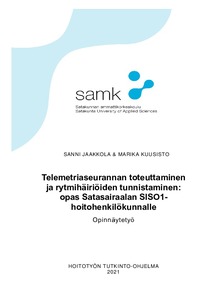Telemetriaseurannan toteuttaminen ja rytmihäiriöiden tunnistaminen: opas Satasairaalan SISO1-hoitohenkilökunnalle
Jaakkola, Sanni; Kuusisto, Marika (2021)
Jaakkola, Sanni
Kuusisto, Marika
2021
All rights reserved. This publication is copyrighted. You may download, display and print it for Your own personal use. Commercial use is prohibited.
Julkaisun pysyvä osoite on
https://urn.fi/URN:NBN:fi:amk-2021052712038
https://urn.fi/URN:NBN:fi:amk-2021052712038
Tiivistelmä
Tämän opinnäytetyön aiheeksi valikoitui telemetriaseurannan toteuttaminen ja rytmihäiriöiden tunnistaminen. Opinnäytetyö toteutettiin yhteistyössä Satasairaalan SISO 1-osaston kanssa. Opinnäytetyön tarkoituksena oli tuottaa opas telemetriaseurannan toteuttamisesta ja rytmihäiriöiden tunnistamisesta Satasairaalan SISO1-osaston hoitohenkilö-kunnalle. Työn tavoitteena oli lisätä hoitohenkilökunnan osaamista ja varmuutta telemet-riaseurannan toteuttamisesta ja osastolla vastaantulevien yleisimipien rytmihäiriöiden tunnistamisessa. Opinnäytetyöntekijöiden tavoitteena oli rytmihäiriöiden teoria- ja tulkintaosaamisen lisääntyminen sekä lisätä tietämystä toiminnallisen projektiopinnäytetyön työstämisestä. Opinnäytetyö toteutettiin toiminnallisena opinnäytetyönä.
Opinnäytetyössä tuotiin teoriatiedon valossa esille sydän, telemetriaseuranta, EKG ja sinusrytmi sekä rytmihäiriöt. Teoriapohjan perusteella tuotettiin A5 kokoinen opas, jossa käsitellään EASI-kytkentä, mahdolliset telemetriaseurannassa esiintyvät häiriöt sekä osastolla yleisimmin esiintyviä rytmihäiriöitä.
Opas palautettiin osastolle arvioitavaksi. Valmis opas otettiin käyttöön Satasairaalan osastolla. Palautteen mukaan opinnäytetyö vastasi tilaajan tarpeita ja työtä voidaan hyödyntää hoitotyössä. Osaston hoitohenkilökunta toi esille, että opas on selkeä ja hyödyllinen käytännöntyössä ja henkilökunnan koulutuksissa. Oppaan hyötyä pidemmältä aika-väliltä voidaan arvioida vasta myöhemmin.
Kehitysehdotuksina opinnäytetyössä tuotiin esille koulutusmahdollisuuden luominen juuri telemetrialaitteessa näkyvien rytmihäiriöiden tulkintaan. Rytmihäiriöiden tulkinta on haastavaa ja sen käymistä olisi hyvä käydä enemmän sairaanhoitajan opinnoissa läpi. The topic of this thesis was the implementation of telemetry monitoring and the identifica-tion of arrhythmias. The thesis was carried out in collaboration with Satasairaala's SISO 1 ward. The purpose of the thesis was to produce a guide on the implementation of telemetry monitoring and the identification of arrhythmias for the medical staff of the SI-SO1 ward of Satasairaala. The aim of the work was to increase the competence and confidence of the nursing staff in the implementation of telemetry monitoring and in the iden-tification of arrhythmias of the most common patients in the ward. The aim of the thesis workers was to increase the theoretical and interpretive skills of arrhythmias and to increase the knowledge about working on a functional projection thesis. The thesis was implemented as a functional thesis.
The heart, telemetry monitoring, ECG and sinus rhythm as well as arrhythmias were highlighted in the thesis in the light of theoretical knowledge. A5-sized guide based on the theoretical basis, which deals with EASI coupling, possible disturbances in telemetry monitoring and the most common arrhythmias in the ward.
The guide was returned to the ward for evaluation. The completed guide was introduced at the Satasairaala’s ward. According to the feedback, the thesis met the client's needs and the work can be utilized in nursing work. The nursing staff of the ward pointed out that the guide is clear and useful in practical work and staff training. The long-term benefits of the guide can only be assessed later.
As development proposals in the thesis, the creation of an educational opportunity for the interpretation of arrhythmias seen in a telemetry device was highlighted. The interpretation of arrhythmias is challenging and it would be a good idea to go through it more in nurse studies.
Opinnäytetyössä tuotiin teoriatiedon valossa esille sydän, telemetriaseuranta, EKG ja sinusrytmi sekä rytmihäiriöt. Teoriapohjan perusteella tuotettiin A5 kokoinen opas, jossa käsitellään EASI-kytkentä, mahdolliset telemetriaseurannassa esiintyvät häiriöt sekä osastolla yleisimmin esiintyviä rytmihäiriöitä.
Opas palautettiin osastolle arvioitavaksi. Valmis opas otettiin käyttöön Satasairaalan osastolla. Palautteen mukaan opinnäytetyö vastasi tilaajan tarpeita ja työtä voidaan hyödyntää hoitotyössä. Osaston hoitohenkilökunta toi esille, että opas on selkeä ja hyödyllinen käytännöntyössä ja henkilökunnan koulutuksissa. Oppaan hyötyä pidemmältä aika-väliltä voidaan arvioida vasta myöhemmin.
Kehitysehdotuksina opinnäytetyössä tuotiin esille koulutusmahdollisuuden luominen juuri telemetrialaitteessa näkyvien rytmihäiriöiden tulkintaan. Rytmihäiriöiden tulkinta on haastavaa ja sen käymistä olisi hyvä käydä enemmän sairaanhoitajan opinnoissa läpi.
The heart, telemetry monitoring, ECG and sinus rhythm as well as arrhythmias were highlighted in the thesis in the light of theoretical knowledge. A5-sized guide based on the theoretical basis, which deals with EASI coupling, possible disturbances in telemetry monitoring and the most common arrhythmias in the ward.
The guide was returned to the ward for evaluation. The completed guide was introduced at the Satasairaala’s ward. According to the feedback, the thesis met the client's needs and the work can be utilized in nursing work. The nursing staff of the ward pointed out that the guide is clear and useful in practical work and staff training. The long-term benefits of the guide can only be assessed later.
As development proposals in the thesis, the creation of an educational opportunity for the interpretation of arrhythmias seen in a telemetry device was highlighted. The interpretation of arrhythmias is challenging and it would be a good idea to go through it more in nurse studies.
